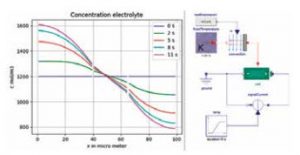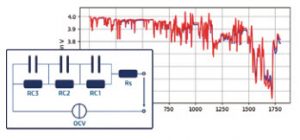This article was originally published in the October 2018 issue of SIMULIA Community News magazine.
THE CATIA BATTERY LIBRARY The Battery library is a Modelica-based library for the modeling of cells and battery packs in a wide range of applications, including auto- motive, aerospace, industrial equipment and process industry. It provides: • Cell models structured into thermal, electrical and aging domains • Battery pack models of different levels of detail (scaled/discretized) • Interfaces and templates for easy customization and extension • Complete insight into the Modelica code Here we present a continuous workflow from an electrochemical (P2DM) to an equivalent circuit cell model (ECM) that enables the investigation of a battery system on multiple levels.
EXPLORING CELL BEHAVIOR WITH ELECTROCHEMICAL CELL MODELS The electrochemical model is a pseudo-2D-model based on the porous electrode and concentrated solution theory. The model predicts the spatially distributed behavior of the essential quantities of the battery, such as concentration of lithium ions and potentials in the electrolyte and the active solid electrode material. Knowledge of these quantities helps to determine the state of the battery as well as its ability to provide energy.

In combination with the Modelica Standard Library (MSL) and other commercial libraries, the user can build test benches of various complexity to investigate the cell in different scenarios and gain knowledge of its capabilities and restrictions.
FROM ELECTROCHEMICAL TO CIRCUIT MODELS The computational effort for the electrochemical model is usually too high to use it for battery pack simulations and/or an integration into a complex system, like a powertrain or an entire vehicle. For this purpose, a faster computing representation of the cell is required. A proven solution for this is an electrical equivalent circuit model (ECM).
The Battery Library offers a Python-based workflow for the generation of lookup tables for an ECM from a P2DM. With these lookup tables, optimized on current pulses performed on the P2DM, the ECM gives a good approximation of the electrical behavior of the cell.

EXPLORING THE BATTERY PACK The battery pack models enable the simulation of the thermal and electrical interaction of multiple cell models. A cell model includes an ECM using the generated tables, a thermal model and an aging model. The thermal model is a network of thermal conductors and capacitors computing the temperatures inside the cell and the heat exchange with the environment. The aging model is usually an empirical model with superimposition of calendar and cyclic aging effects.
With the pack models, all kinds of investigations are possible: • How do differences in cell characteristics (e.g. capacity, state of charge) affect performance? • How do different cooling strategies behave? • How is the performance of the pack integrated into the system?
BRIDGING SCALES 3DEXPERIENCE and the Multiscale Systems Specialist Role make it possible to link Modelica-based behavior models (or any FMI compliant model) with 3D Finite Element models in a co-simulation fashion. This allows, for example, conducting a thermal analysis on a battery module in which the heat generated by the battery cells is modeled at the 0D scale while the cooling of the battery module can be modeled in the 3D domain with Computational Fluid Dynamics (CFD). This is done in order to pass the current cell temperatures back to the Modelica-based behavior models for loss recalculation as the properties used to calculate these losses are temperature dependent.
For More Information: www.3ds.com/products-services/catia/disciplines/systems-engineering/

